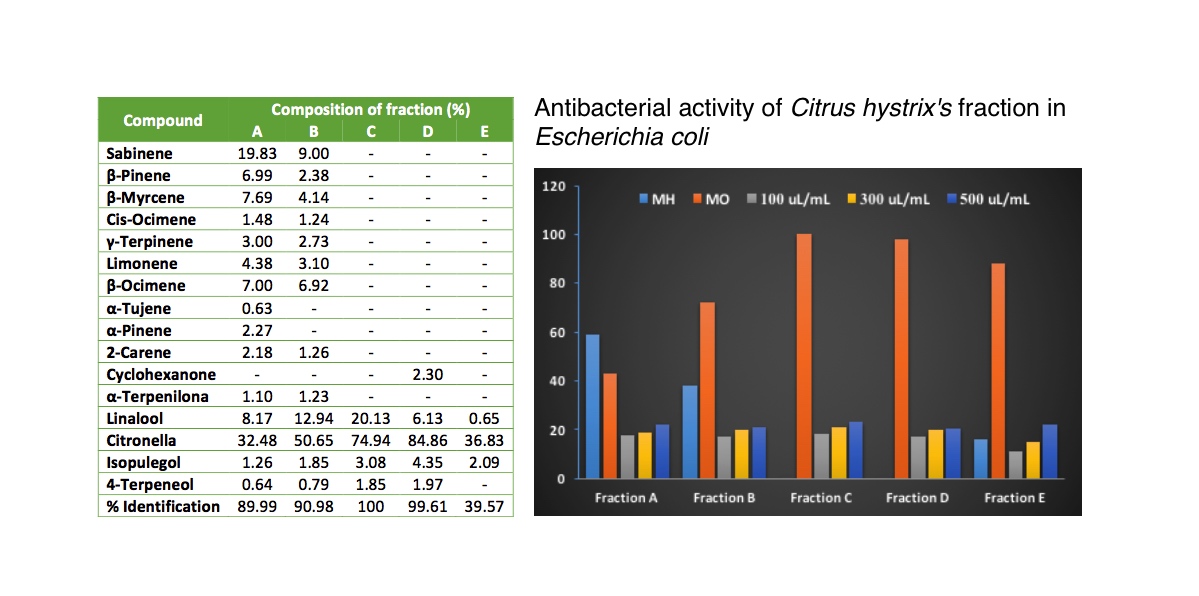Chemical Composition of Oil Fraction Kaffir Lime (Citrus hystrix DC) as Antibacterial Activity of E.coli
Abstract

The purpose of this research is to know the composition of fraction oil kaffir lime which is consist as antibacterial activity E.coli. This research uses kaffir lime oil from a branch for fractional distillation use PiloDist 104-VTU (number the stages 120), and reflux ratio 20/10 with 5 mbar pressure. Oil kaffir lime composition analysis use GC-MS (type Shimadzu QP 2010S) with a gas helium on speed 3mL/minute. Antibacterial activity assay use agar well diffusion assay which does in three concentration they are 500 µL/mL, 300 µL/mL, 100 µL/mL. The result of oil fraction kaffir lime has five fraction oil based on boiling point interval, they are A fraction oil (63,00 – 70,010 C), B fraction (71,30 – 70,800 C), C fraction (74,50 – 74,200 C), D fraction (74,20 – 74,000 C) and E fraction (72,90 – 91,100 C). The result of this research obtained five oil fraction they are monoterpene oxygenated (MO) except A oil fraction with monoterpene hydrocarbon composition (MH) 12,1%. The main component of a fraction which MO compound they are citronella, linalool and isopulegol, while in MH compound they are sabine, β-pinen, β-micren and limonene. The result of antibacterial activity assay obtained on highest concentration it is 500 µL/mL. Antibacterial activity assay also depends on fraction composition with higher composition of MO. The highest MO components of oil fraction on C oil fraction which has MO component such as citronella 74,94%; linalool 20,13%; and isopulegol 3,08%.
References
[1]. Nascimento, G. G. F., Juliana .L, Paulo C. F, Giuliana L. S, Braz J Microbiol, 2000, 31, 247-256. website
[2]. Souza, C. A. S., Avancini, C. A. M., Wiest, J. M., Braz. J. Vet. Res. Anim. Sci., 2000, 37(6), 429-433. crossref
[3]. J. Wungsintaweekul, W. Sitthithaworn, W. Putalun, H. W. Pfeifhoffer and A. Brantner, Songklanakarin J. Sci. Technol., 2010, 32(6), 589-598. website
[4]. Srisukh, V., N. Bunyapraphatsara, A. Pongpan, W. Tungrugsasut, S. Puttipipatkhachorn, W. Oniam, T. Karawamitr, S. Bunsiriluk, and W. Thongbainoi, MUJPS, 2012, 39 (2), 15-27. website
[5]. Warsito, Noorhamdani A. S, Sukardi, Suratmo, Chemical Compositions and Antioxidant Activity of Fraction and Kaffir Lime (Citrus Hystrix) Oils, 2013, Superior Report of Universitas Brawijaya.
[6]. Adams R. P., Identification of Essential Oils components by Gas Chromatography/Quadrupole Mass Spectroscopy, 4th ed, 2001, Allured Publishing Corp, Carol Stream, IL, USA.
[7]. Sarikurkcu, C., G. Zengin, M. Oskay, S. Uysal, R. Ceylan, A. Aktumsek, Ind Crops Prod., 2015, 70, 178-184. crossref
[8]. Loh, F. S, Rita Muhamad Awang, Dzolkhifli Omar and Mawardi Rahmani, J. Med. Plants Res., 2011, 5(16), 3739-3744. website
[9]. Parekh J., Chanda S., Turkish J. Biol., 2007, 31, 53-58. website
[10]. Chanthaphon, S., Suphitchaya .C, and Tipparat .H, Songklanakarin J. Sci. Technol., 2008, 30 (1), 125-131. website
[11]. Hussain, A. I., Anwar, F., Hussain Sherazi, S. T., and Przybylski, R, Food Chem, 2008, 108(3), 986-995. crossref
[12]. Bakkali, F., Averbeck, S., Averbeck, D., Idaomar, M., Food Chem Toxicol, 2008, 46(2), 46, 446-475. crossref
[13]. Sokovic M. and Griensven L. J. L. D, Eur J Plant Pathol., 2006, 116-211. website
[14]. Magiatis P., Melliou E., Skaltsounis A.L., Chinou I. and Mitaku S, Planta medica., 1999, 65, 749. website
[15]. Y. Jiang, N. Wu, Y.-J. Fu, W. Wang, M. Luo, C.-J. Zhao, Y.-G. Zu, X.-L. Liu, Environ Toxicol Pharmacol., 2010, 32(1), 63-8. crossref
[16]. Zhu, L, Y. J Tian, Y. C Yin and S. M. Zhu, IJFS, 2012, 24, 19-25. website
[17]. Kurita, N., Miyaji, M., Kurane, R., Takahara, Y. and Ichimura, K, Agric Biol Chem., 1981, 45, 945–952. website
[18]. Pelczar, M. J., Chan, E. C. S. and Krieg, N.R. Control of microorganisms, the control of microorganisms by physical agents, 2th Edition, 1988, New York, McGraw-Hill International.
[19]. Sivarooban, T., Hettiarachchy, N. S., Johnson, M. G., J Food Prot., 2008, 71, 2105–2109. website
[20]. Kurita, N., Miyaji, M., Kurane, R., Takahara, Y. and Ichimura, K., Agric Biol Chem., 1979, 43, 2365–2371. website
[21]. Dormans, H. J. D., Deans, S. G, J Appl Microbiol, 2000, 88, 308–316. website
[22]. Gill, A. O., Holley, R. A., Appl Environ Microbiol, 2004, 70, 5750–5755. website
[23]. Moosavy, M. H., Basti, A. A., Misaghi, A., Zahraei, T., Abbasifar, R., Ebrahimzadeh, H. A., Alipour, M., Emami Razavi, N., Gandomi, H., Noori, N., Food Res Int., 2008, 41, 1050–1057. crossref
[24]. Chan, A. C., Ager, D., Thompson, I. P., J Microbiol Methods, 2013, 93, 209–217. crossref
[25]. Andrews R. E., Parks L. W. and Spence K. D, Appl Environ Microbiol, 1980, 40, 301. crossref
[26]. Uribe S., Ramirez J. and Pena A, Am Soc Microbiol, 1985, 161, 1195. website
[27]. Donsi F., Annunziata M., Sessa M. and Ferrari G, Lebensm. Wiss. Technol., 2011, 44, 1908-1914. crossref
[28]. Delaquis P. J., Stanich K., Girard B., Mazza G, Int J Food Microbiol, 2002, 74,101–109. crossref
[29]. Burt, S., Int J Food Microbiol, 2004, 94, 223-253. crossref
[30]. Edris, A. E., Phytother Res, 2007, 21, 308–323. website
[31]. Dormans, H. J. D., Deans, S. G, Phytother Res, 2000, 88, 308–316. crossref
[32]. Lambert, R. J. W., Skandamis, P. N., Coote, P. J., Nychas, G. J. E., J Appl Microbiol, 2001, 91, 453–462. crossref
Refbacks
- There are currently no refbacks.

This work is licensed under a Creative Commons Attribution-NonCommercial 4.0 International License.








